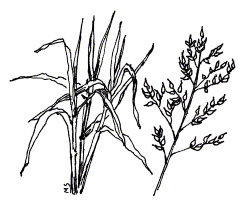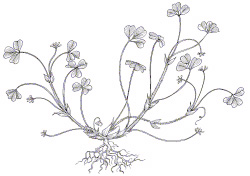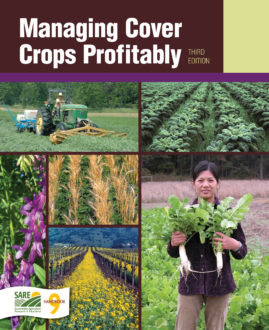
How to Use This Book
Think of this book as a tool chest, not a cookbook. You won’t find the one simple recipe to meet your farming goals. You will find the tools to select and manage the best cover crops for the unique needs of your farm.
In this tool chest you will find helpful maps and charts, detailed narratives about individual cover crop species, chapters about specific aspects of cover cropping and extensive appendices that will lead you to even more information.
1. Start with Top Regional Cover Crop Species. This chart will help you narrow your search by listing the benefits you can expect from the top cover crops adapted to your region. You’ll discover which are the best nitrogen (N) sources, soil builders, erosion fighters, subsoil looseners, weed fighters and pest fighters.
2. Next, find out more about the performance and management of the cover crops that look like good candidates for your farm. You’ll find two streams of information:
- Charts quickly provide you with details to help you compare cover crops. Performance and Roles lists ranges for N and dry matter production and ranks each cover crop’s potential for providing 11 benefits. Cultural Traits and Planting explains the growth, environmental tolerances, seeding preferences and establishment costs for each crop.
- Narratives. The Table of Contents and the page numbers accompanying each species in Charts 2, 3 and 4 direct you to the heart of the book, the chapters on each cover crop. The chapters offer even more practical descriptions of how to plant, manage, kill and make the best use of each species. Don’t overlook Up-and-Coming Cover Crops that briefly describes promising but lesser known cover crops. One of them may be right for your farm.

3. With some particular cover crops in mind, step back and look at the big picture of how you can fit cover crops into your farming operations. Sit down with a highlighter and explore these chapters:
- Benefits of Cover Crops explains important cover crop roles such as reducing costs, improving soil and managing pests.
- Selecting the Best Cover Crops helps you evaluate your operation’s needs and niches (seasonal, cash-crop related, and profit potential). Several examples show how to fit crops to detailed situations.
- Building Soil Fertility and Tilth shows how cover crops add organic matter and greater productivity to the biological, chemical and physical components of soil.
- Managing Pests with Cover Crops explores how cover crops change field environments to protect cash crops from insects, disease, weeds and nematodes.
- New this edition: Managing Cover Crops in Conservation Tillage Systems provides management details for cover crops in reduced tillage systems.
- Crop Rotations explains how to integrate cover crops and cash crops in sequence from year to year for optimum productivity from on-farm resources.
- Citations Bibliography lists many of the publications and specialists cited in the book. Citations within the book are numbered in parentheses. Refer to the numbered citation in the bibliography if you want to dig deeper into a topic.
- Climatic Zone Maps inside the front and back covers help you understand differences in cover crop performance from location to location. You may find that some cover crops have performed well in tests far from where you farm, but under comparable climatic conditions.
The USDA Plant Hardiness Zone Map (insided front cover) shows whether a crop will survive the average winter in your area. We refer to the USDA hardiness zones throughout the book. Readers’ note: a new version of this map is expected in 2008. See the online version of this book at sare.org.
The U. S. Forest Service map, Ecoregions of the United States (inside back cover), served in part as the basis for the adaptation maps included at the beginning of each cover crop chapter. This ecosystem map, while designed to classify forest growth, shows localized climate differences, such as rainfall and elevation, within a region. See Bailey in Appendix F for more information about ecoregions.
4. Now that you’ve tried out most of the tools, revisit the charts and narratives to zero in on the cover crops you want to try. The Appendices include information to help you run reliable onfarm cover crop comparison trials. You’ll also find contact information for cover crop experts in your region, seed and inoculant suppliers, references to books and academic papers cited in this book and websites with more cover crop information.
5. Finally, share your cover crop plans with farmers in your area who have experience with cover crops. Your local Extension staff, regional IPM specialist or a sustainable farming group in your area may be able to provide contacts. Be sure to tap local wisdom. You can find out the cover crop practices that have worked traditionally, and the new wrinkles or crops that innovative practitioners have discovered.
Abbreviations used in this book
A = acre or acres
bu. = bushel or bushels
DM = dry matter, or dry weight of plant material
F = (degrees) Fahrenheit
in. = inch or inches
K = potassium lb. = pound or pounds
N = nitrogen
OM = organic matter
P = phosphorus
p. = page
pp. = pages
T = ton or tons
> = progression to another crop
/ = a mixture of crops growing together
